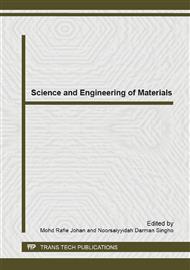[1]
Dilip Sahebrao Ingole, Abhay Madhusudan Kuthe, Shashank B. Thakare, Amol S. Talankar, Rapid prototyping – a technology transfer approach for development of rapid tooling, Rapid Prototyping Journal, 15/4 (2009) 280–290.
DOI: 10.1108/13552540910979794
Google Scholar
[2]
C. W. Lee, C. K. Chua, C. M. Cheah, L. H. Tan, C. Feng, Rapid investment casting: direct and indirect approaches via fused deposition modeling, International Journal of Advanced Manufacturing Technology (2004) 23: 93–101.
DOI: 10.1007/s00170-003-1694-y
Google Scholar
[3]
Addanki Sambasiva Rao, Medha A. Dharap, J V L Venkatesh, Deepesh Ojha, Investigation of post processing techniques to reduce the surface roughness of fused deposition modeled parts, International Journal of Mechanical Engineering and Technology, Volume 3, Issue 3, September - December (2012).
Google Scholar
[4]
Omar M.F.M., S. Sharif, M. Ibrahim, H. Hehsan, M.N.M. Busari and Hafsa M.N., Evaluation of Direct Rapid Prototyping Pattern for Investment Casting, Advanced Materials Research Vols. 463-464 (2012) pp.226-233, Trans Tech Publications, Switzerland.
DOI: 10.4028/www.scientific.net/amr.463-464.226
Google Scholar
[5]
W. S. W. Harun, S. Safian & M. H. Idris, Evaluation of ABS patterns produced from FDM for investment casting process, Computational Methods and Experiments in Materials Characterization IV 319, WIT Transactions on Engineering Sciences, Vol 64, © 2 009 WIT Press.
DOI: 10.2495/mc090301
Google Scholar
[6]
Yuhua Song, Yongnian Yan, Renji Zhang, Qingping Lu, Da Xu, Three dimensional non-linear coupled thermo-mechanical FEM analysis of the dimensional accuracy for casting dies in rapid tooling, Finite Elements in Analysis and Design 38 (2001) 79-91.
DOI: 10.1016/s0168-874x(01)00048-8
Google Scholar
[7]
J.C. Ferreira, N.F. Alves, Integration of reverse engineering and rapid tooling in foundry technology, Journal of Materials Processing Technology 142 (2003) 374–382.
DOI: 10.1016/s0924-0136(03)00601-0
Google Scholar
[8]
M.D. Monzon, N. Diaz, A.N. Benitez, M.D. Marrero, P.M. Hernandez, Advantages of Fused Deposition Modeling for making electrically conductive plastic patterns, 2010 International Conference on Manufacturing Automation, 978-0-7695-4293-5/10, 2010 IEEE DOI 10. 1109/ICMA. 2010. 36.
DOI: 10.1109/icma.2010.18
Google Scholar
[9]
Sarat Singamneni, Roger Anak Joe, Bin Huang, Adaptive Slicing for Fused Deposition Modeling and Practical Implementation Schemes, Advanced Materials Research Vol. 428 (2012) pp.137-140.
DOI: 10.4028/www.scientific.net/amr.428.137
Google Scholar
[10]
P.M. Pandey, N.V. Reddy, S.G. Dhande, Real time adaptive slicing for fused deposition modeling, International Journal of Machine Tools & Manufacture 43 (2003) 61–71, Pergoman, Elsevier.
DOI: 10.1016/s0890-6955(02)00164-5
Google Scholar
[11]
Anhua Peng, Zhiming Wang, Researches into Influence of Process Parameters on FDM Parts Precision, Applied Mechanics and Materials Vols. 34-35 (2010) pp.338-343.
DOI: 10.4028/www.scientific.net/amm.34-35.338
Google Scholar


